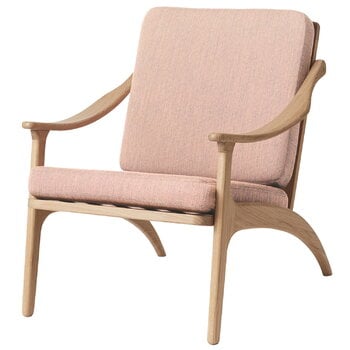The Lean Back lounge chair, designed by Arne Hovmand-Olsen in 1957, is a Danish design classic that has been re-released by Warm Nordic. Lean Back got its name from the relaxed shape of the backrest that invites you to sit down and lean back. The flowingly shaped wooden chair is a fine example of Arne Hovmand-Olsen’s love for top-quality materials and airy design. Thanks to its lightweight structure and harmonic appearance from front to back, Lean Back will find its place either by the wall or at the center of the room.
Lean Back lounge chair, white oiled oak - rose
Warm Nordic
Description
The Lean Back lounge chair, designed by Arne Hovmand-Olsen in 1957, is a Danish design classic that has been re-released by Warm Nordic. Lean Back got its name from the relaxed shape of the backrest that invites you to sit down and lean back. The flowingly shaped wooden chair is a fine example of Arne Hovmand-Olsen’s love for top-quality materials and airy design. Thanks to its lightweight structure and harmonic appearance from front to back, Lean Back will find its place either by the wall or at the center of the room.
Product details (13)
- Colour
- White oiled oak, pale rose
- Width
- 26.77 in (68 cm)
- Depth
- 31.5 in (80 cm)
- Height
- 30.71 in (78 cm)
- Seat depth
- 19.69 in (50 cm)
- Seat height
- 16.54 in (42 cm)
- Frame material
- White oiled solid oak
- Seat cushion
- Foam
- Backrest cushion
- Foam
- Upholstery fabric
- Kvadrat: Canvas 614, 90% wool, 10% nylon
- Abrasion resistance
- 100,000 Martindale
- Pilling
- 4
- Lightfastness
- 6
- Product ID
Designer
Danish furniture designer Arne Hovmand-Olsen (1919-1989) started his career in 1938 as a cabinetmaker for P.Olsen Sibast. After studying furniture design in a technical school, Hovmand-Olsen founded his own workshop with great success – his designs gained success not only in Denmark but also internationally, especially in the United States.
Arne Hovmand-Olsen was born in 1919 in Denmark in a farm family. He quickly developed an interest for drawing and creation. He started his career in 1938 by an apprenticeship as cabinet maker for P.Olsen Sibast. He really wanted to produce his own creation. He decided to study in a technical school dedicated to furniture design. Once he finished his training program, he founded his own workshop. He quickly met with great success: he sold in Denmark but especially in the United States! His workshop closed during the 1970.
View all productsReviews (0)
Sustainability
The Product Sustainability Framework, our criteria of sustainable design, helps you find the most sustainable products in our selection. Read below which sustainability criteria this product has met.
Working conditions & labour 9/9
-
Equal opportunities for all employees
-
Commitment to UN Global Compact, fair compensation for all employees
-
Corporate responsibility requirements defined and communicated for suppliers
-
Systematic work for improved inclusion and well-being in the workplace
-
Transparent supply chain
-
Suppliers' compliance to a code of conduct ensured
-
Direct suppliers audited and certified
-
Compliance to the UN Guiding Principles on Business and Human Rights ensured in the supply chain
-
Support for community involvement in the supply chain
Eco-friendly production 7/9
-
Fair and resource-wise water-use in production
-
No incineration or landfilling of returned items
-
No use of endangered species as materials
-
No direct environmental emissions or waste (excl. GHGs) from production
-
Material-efficient and ecological packaging
-
Positive impact on nature’s well-being through operations that regenerate natural ecosystems
-
No potentially harmful chemicals used in own production
-
The sustainability of direct suppliers' production is addressed and monitored
-
Production and material sourcing that respect biodiversity, animal rights, and natural ecosystems
Climate impact 4/8
-
Company's direct greenhouse gas emissions identified and commitment to reduction
-
Product's carbon impact identified and commitment to reduction
-
Guidance on energy- and eco-efficient use of the product
-
Contribution to climate initiatives beyond the brand’s direct operations
-
Low-carbon or compensated transportation
-
Carbon footprint of the product calculated and goals set to reduce it
-
100 % renewable energy in own production and operations
-
Carbon neutral or carbon negative product
Sustainable materials 4/6
-
Sustainable and long-lasting material choices
-
No harmful or hazardous substances
-
Responsible raw material sourcing and production
-
Materials suited for circularity: monomaterials, recyclable finishings, renewable or recycled contents etc.
-
Ecological materials: natural, biodegradable, recyclable or recycled contents
-
Outstanding materials in terms of innovativeness, responsibility, sustainability and circularity: local production or sourcing, 100 % recycled content, C2C-certification etc.
Circular design 4/5
-
High aesthetic quality promoting long-term use of the product
-
Technically durable product design and material choices
-
Design for enduring life-long quality
-
Design and support for product maintenance, repair and upgradability
-
Innovative circular design solutions: circular service system, resale platform, remanufacturing, collection of used products, etc.





